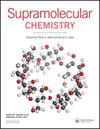酰胺链树突类两亲分子:一类pH敏感且具有高度生物相容性的药物缓释载体
IF 2.6
4区 化学
Q3 CHEMISTRY, MULTIDISCIPLINARY
引用次数: 0
摘要
研究了聚乙二醇-枝状酰胺连接的两亲性胶束,以提高疏水分子的溶解度。采用紫外技术对疏水性芘染料进行包封研究。在中性ph和室温(ph 7.0和28°C)下获得了非离子两亲体的包封效率。G.3树突基非离子型油酸(C18-cis)两亲体包封率为78.2%。研究表明,在37℃下,酰胺连接的G.1树突基非离子(c18 -顺式)两亲体在ph . 6.2和ph . 7.0条件下,72 h的染料释放率分别为78.00%和26.19%。体外细胞毒理学研究表明,在浓度高达31.25 μg/mL的条件下,G.1酰胺两亲体在处理24 ~ 48 h后,细胞存活率可达80%以上。用香豆素6证明了细胞摄取。该两亲体具有生物相容性,可用于生物医学领域的药物包封和靶向给药。图形抽象本文章由计算机程序翻译,如有差异,请以英文原文为准。
Amide-Linked Dendron-based Amphiphiles: A class of pH sensitive and highly biocompatible drug carrier for sustained drug release
ABSTRACT PG-dendritic amide-linked amphiphilic micelles were studied to increase the solubility of hydrophobic molecules. The encapsulation study was done by utilising hydrophobic pyrene dye using U.V. technique. The encapsulation efficiency of the non-ionic amphiphiles was obtained at neutral p.H. and at room temperature (p.H. 7.0 & 28 °C). The G.3 dendron-based non-ionic oleic (C18-cis)-amphiphile was found to have the 78.2% encapsulation efficiency. Studies show that the amide-linked G.1 dendron-based non-ionic (C18-cis) amphiphiles have sustained dye release percentage of 78.00% at p.H. 6.2 and 26.19% at p.H. 7.0 in 72 h at 37 °C. The in vitro cyto-toxicological studies showed that after 24–48 h treatment, the G.1 amide amphiphiles exhibit more than 80% of cell viability for concentration as high as 31.25 μg/mL. The cellular uptake was demonstrated using Coumarin 6. The integrated amphiphiles are biocompatible and can be used in the biomedical field as medication encapsulation and target drug delivery. Graphical abstract
求助全文
通过发布文献求助,成功后即可免费获取论文全文。
去求助
来源期刊

Supramolecular Chemistry
化学-化学综合
CiteScore
3.60
自引率
3.00%
发文量
5
审稿时长
2.7 months
期刊介绍:
Supramolecular Chemistry welcomes manuscripts from the fields and sub-disciplines related to supramolecular chemistry and non-covalent interactions. From host-guest chemistry, self-assembly and systems chemistry, through materials chemistry and biochemical systems, we interpret supramolecular chemistry in the broadest possible sense. Interdisciplinary manuscripts are particularly encouraged. Manuscript types include: high priority communications; full papers; reviews, and; Methods papers, techniques tutorials highlighting procedures and technologies that are important to the field. We aim to publish papers in a timely fashion and as soon as a paper has been accepted and typeset it will be published in electronic form on the Latest articles section of the website. The two most important review criteria are that the paper presents high-quality work that fits generally into the broad spectrum of activities in the supramolecular chemistry field. Under normal circumstances, Supramolecular Chemistry does not consider manuscripts that would be more suitable in a highly specialized journal. This includes, but is not limited to, those based mostly or exclusively on topics such as solid state/X-ray structures, computational chemistry, or electrochemistry. .
The two most important review criteria are that the paper presents high-quality work that fits generally into the broad spectrum of activities in the supramolecular chemistry field.
 求助内容:
求助内容: 应助结果提醒方式:
应助结果提醒方式:


